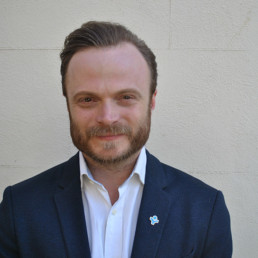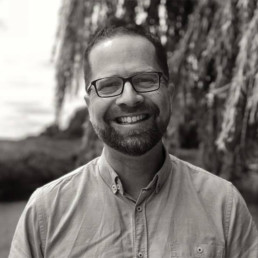The Heterosexual Matrix

Written by Dr Adam Brett
Adam has completed a doctorate exploring the experiences of LGBT+ secondary teachers. A presentation of his findings can be found here. He also co-hosts a podcast called Pride and Progress, @PrideProgress, which amplifies the voices of LGBT+ educators, activists and allies.
“Children who need to be taught to respect traditional moral values are being taught that they have an inalienable right to be gay”
– Margaret Thatcher, October 1987.
Thanks for that, Margaret. You and your government created a culture of fear, silence and moral panic surrounding LGBT+ lives that continues to this day. Your speech continued, that “all of those children are being cheated of a sound start in life – yes, cheated!”.
She was right about one thing. Section 28 meant children were being cheated of a sound start in life.
Section 28 cemented schools as heteronormative spaces, where being heterosexual and cisgender were silently assumed, leaving LGBT+ people with the impossible decision or whether to be invisible or hyper-visible.
What a choice to have to make.
Do I hide my authentic self to fit in with the legislated normativity of schools, or do I make myself visible and put myself at professional and personal risk?
Patai (1992) refers to this form of hyper-visibility as ‘surplus visibility’, where a person is ‘extrapolated from part to whole’ and seen to represent the entirety of a minority group.
You might be thinking that a lot has changed since the repeal of Section 28 nearly 20 years ago in England. It’s true, a lot has changed and there has been significant cultural and legislative improvements for LGBT+ people. However, schools remain stubbornly heteronormative and cisnormative environments.
Think about the aspects of school that are predicated on a static, binary gender. Toilets; changing rooms; sports; gendered language; uniform; seating plans; residentials. The list goes on. What does this communicate for those who cannot or will not fit into the neat binary of male or female? That they don’t belong.
We could consider similar examples about the ways in which heteronormativity is maintained as the social order in schools. The curriculum; ethos; culture; policies; microaggressions; homophobia; the hidden curriculum; role models.
We can conceptualise all these examples as code.
I love to use the film The Matrix as a metaphor to explain the ways in which socially constructed ideas such as heteronormativity are held in place. When we are plugged into the matrix, we believe it’s real and can’t see the code that is continually constructing it. We can’t imagine alternatives as it’s all there is, in the same way that we can’t think outside of language.
However, when we develop the critical awareness of what is upholding this normativity and develop a language to name it, we become unplugged. LGBT+ people have the critical awareness to identify the ways in which schools seek to include or exclude them. Section 28 plugged us into a matrix of understanding where the silent assumption of cisgendered heterosexuality was so entrenched, that to this day, being an LGBT+ person in school can be a point of constant navigation and information management. Exhausting.
As educators and leaders, we need to listen to the lived experiences of our LGBT+ students and colleagues to create a culture, curriculum and language which can disrupt this code. We need to name things as heteronormative; we need to name things as cisnormative; we need to name things as microaggressions. We need a new language: one that allows us to think outside of the current heterosexual matrix. We need to create schools and spaces where LGBT+ people feel safe and included, without attracting surplus visibility.
Section 28 cheated a whole generation of LGBT+ young people out of a sound start in life. It’s time to unplug the matrix and make sure it doesn’t happen to the next generation.
Adam Brett
@DrAdamBrett
Do This, Not That

Written by Jaya Hiranandani
Jaya is an international school teacher currently based in Taipei, Taiwan. She is in awe of the unlimited potential of the learning that can happen in the classroom and, as a result, is passionate about inquiry-based learning, student and staff wellbeing, and DEI.
I am from the north of India and I believe that a combination of deeply ingrained acceptance of hierarchy and authority, assumption of best intentions and sheer luck have helped me live in a foreign country and in multiple international communities relatively unscathed from the effects of overt racism.
However, I have spent a lot of time baffled and confused by covert racism. Covert racism are often instances of racism so subtle that the victim is left wondering if they have been discriminated against. Psychologist Derald Wing Sue, Ph.D. from Teachers College Columbia University defines “racial microaggression” as “one of the “everyday insults, indignities and demeaning messages sent to people of colour by well-intentioned white people who are unaware of the hidden messages being sent to them.”
Covert acts of racism, apart from being distressing and confusing for the recipient, can be difficult for people from the dominant culture to accept “because it’s scary to them,” Professor Sue asserts, “It assails their self-image of being good, moral, decent human beings to realise that maybe at an unconscious level they have biassed thoughts, attitudes and feelings that harm people of colour.”
When I was sidelined, ignored or marginalised, the younger me was left wondering- Was it me, them or the situation? Am I being too sensitive? Did I do something wrong? Is it just an individual personality trait or is there something bigger here? Is this person incapable of trusting me just because I am different from them? Am I being sidelined because I am not interesting enough, or is the other person just having a bad day? Is this person not interested in knowing me because they think they already “know” how I am from their experiences with other people of my ethnicity?
As I grew older, patterns began to emerge and I have realised that ALL these could be true in one situation or the other and I have gotten better at deciphering between my own sensitivities and other people’s biases.
Here are six suggestions I have to develop awareness about and avoid engaging in covert racism at our educational institutions:
1. Learn how to say my name correctly, don’t hesitate to ask if needed
First things first: Yes, the names of people of colour often sound unfamiliar or sometimes, difficult to pronounce correctly. Try your best to pronounce them correctly, ask for guidance and never shorten someone’s name for your convenience before asking them first.
2. Be socially inclusive, but don’t overcompensate
You don’t need to become my friend, you just need to be friendly and considerate.
At a previous school of mine, I was unwelcome at the staff book club for many years. There was a poster about it on the staff bulletin board and when I expressed my interest to the book club leads, I was given sketchy details in a lukewarm tone with no invitation forthcoming. It was not until someone posted a well meaning invitation on the school’s online social messaging board that I was let in. I still can’t be sure why I was kept out of a monthly get-together based on a love for reading which I shared with the members of the group.
People of colour understand that you will be more comfortable with people who you can discuss your food with and can complain about things with; we know this because we do the same. Humans are wired to seek out people with similar experiences as theirs- it helped us during our cave-residing days when it was important to stick to our tribe to stay safe. We instinctively connect with people who share our culture and in my experience, a shared culture transcends shared race or ethnicity. So none of us should be under any kind of pressure to have diverse-looking close friends as long as we treat people fairly, equally and respectfully.
When we value people for their intrinsic qualities, we will naturally include diverse people in our social circles. When we look beyond people’s idiosyncrasies and external looks, we find the people we share our values and ambitions with.
3. Find diverse ways to talk to people of colour, don’t just discuss topics related to their race or country
I have a colleague who always talks to me about food, clothes or movies from my country. We have worked together for half a dozen years and it makes me wonder if she sees me as a multifaceted person that I am.
Do you feel compelled to talk to ethnically diverse people only about their country or culture? Or do you plunge into awkward silence wondering what on earth you should talk about that will not be offensive and will be politically correct? Find the middle path. Yes, I am happy to talk about which Indian restaurant in town I find the most authentic. No, I don’t want to be always seen through the lens of my ethnicity as I am so much more beyond my origins.
4. People of colour commit racist faux pas too, don’t ignore it.
Racial prejudice oc4urs both ways and though it cannot be termed as racism due to imbalances in power held by white people and people of colour, there is no reason to condone it. When you see or hear POC being racially biased, gently question their judgement and call it out.
5. Talk openly about racial, cultural, ethnic differences, don’t be colourblind
Once when I mustered the courage to mention to a white male school leader that, ambiguous as it is, covert racism in international schools does exist, I was immediately and emphatically told that “no one is out there to get me” and basically made to feel that I was being too sensitive! Denying that racism in any form exists around us is colour blindness and it is a sureshot way to shut any dialogue about it.
Colorblindedness denies the prevalence of differences based on race and though it is rooted in the goal to promote racial equality based on race-neutral policies, it has led to perpetration of systemic racism. If we pretend that race does not exist, we deny the presence of race-based inequities in our communities. Open dialogue about racial and ethnic differences at your school as and when needed. A paper published by Harvard social scientists in The Current Directions in Psychological Science states that, “people exposed to arguments promoting colour blindness have been shown to subsequently display a greater degree of both explicit and implicit racial bias.”
The responsibility of open dialogue about bias, prejudice and race falls more heavily on leaders, and it’s important that schools are now developing explicit DEI (Diversity, Equity and Inclusion) policies for all stakeholders to follow.
6. Develop self-awareness about your biases, don’t equate good intentions with correct action
It has taken me years of catching myself judging people with tattoo-covered bodies to stop making assumptions about them. I recently briefly dated a person with a wing chest tattoo and a whole arm covered with a colourful assortment of motifs and images, and I learnt intriguing stories behind some of his body art.
When we observe our own thoughts and examine our biases and assumptions, we can check ourselves every time we make a sweeping generalisation in our heads about someone based on their ethnicity or physical features.
Sometimes issues will be attributed to bias even though they may have stemmed from poor communication, differences in expectation, individual personality traits and so on. Again, be curious and ready to find out more.
Most of us genuinely want to live in a diverse and inclusive world with equity for all. However, the best intentions are futile if they are not met with the right actions. Let’s marry our best intentions with wholehearted efforts and create workplaces where no one feels marginalised because of their physical features and colour.
References:
DeAngelis, Toni 2009 Unmasking ;Racial Microaggressions’ American Psychological Association Vol. 40, (No. 2) pp. 42 <https://www.apa.org/monitor/2009/02/microaggression>
Alberta Civil Liberties Research Center (ACLRC) The Myth of Reverse Racism Accessed January 2022 <https://www.aclrc.com/myth-of-reverse-racism>
Afpelbaum, E.P., Norton, M.I., and Sommers, S.R. 2012 “Racial Color Blindness: Emergence, Practice and Implications” Current Directions in Psychological Science 21 (3) pp.206 <https://www.hbs.edu/ris/Publication%20Files/Racial%20Color%20Blindness_16f0f9c6-9a67-4125-ae30-5eb1ae1eff59.pdf>
Stephen M.R. Covey May 2021, Association of California School Administrators, Accessed January 2022 <https://content.acsa.org/six-ways-to-help-your-schools-be-more-inclusive/>
#HonestyAboutEditing - The Campaign

Written by Suzanne Samaka
Suzanne Samaka is a 33-year-old mum from Watford. She grew up in a single parent, working class family, which has given her a strong sense of working hard to achieve. She has spent 15 years working for a high street bank in a number of roles, mainly around relationships and people.
How can I make a difference to the mental health of our young people? That was my question and it hit me like a lightning bolt one evening. To give some context to my life, I am a stepmother to four children, have a two year old daughter and have recently given birth to my second baby. I also work full time in banking.
Sadly, for the past four years a member of our family has suffered with anorexia. It is fair to say we will never know the root cause of this and maybe neither will they, but it is apparent that they are not alone in the anxiety, depression, physical and mental health challenges that they have faced in their adolescent years. I’ve been to eating disorder in-patient clinics and I have always been shocked and saddened by how full these units are with adolescent girls and boys alike.
The pandemic has meant young people have spent more time at home and online but I must stress this isn’t only a post-pandemic problem. They are seeing more content than ever that is edited or filtered and it is having a disastrous effect on their self-esteem. The statistics don’t lie and in the UK, 9 out of every 10 girls with low body esteem, put their health at risk by not seeing a doctor or by skipping meals. A survey conducted by the Royal Society for Public Health asked 14-24 year olds in the UK how social media platforms impacted their health and well-being. The survey results found that Snapchat, Facebook, Twitter and Instagram were all linked to increased feelings of depression, anxiety, poor body image and loneliness. More than two thirds (68%) of young people surveyed support social media platforms highlighting when a photo has been manipulated.
I have been contacted by many teachers who have told me about conversations with their students who feel under pressure from social media perfection or crippling loneliness when they feel that their face doesn’t fit. I have also been contacted by countless parents who are terrified of how body conscious their children are, with ages starting from as young as 8. I have also spoken with many adults who have suffered their own mental health challenges in their adolescent years, signing the petition because they just can’t fathom how they would have survived against the odds that the youth of today are growing up with. The more people I speak to about the petition, the more it makes me want to ensure there is change, protection and honesty to give our young people a fair chance in today’s world.
Now there is one thing I need to make crystal clear. I have nothing against social media. In fact I think it can be hugely positive to all of our lives. I also have nothing against editing or filtering, it is completely each to their own. What I have a problem with is the lack of honesty, which is causing young people to believe they need to be flawless yet striving for this is damaging their mental health. Do I believe social media is the problem for the challenges in youth mental health? No. Does it exacerbate the problem? Absolutely. Mental health challenges can quickly become deeply rooted and leave scars for life. Our children and young people deserve better than that.
In trying to evoke change I have recently begun a petition on Change.org to amend the social media laws to state when an image has been filtered or digitally edited. This is now the law in a number of countries, Norway being the most recent. If it can happen there why not in the UK? What I am hoping this solution could do is to help our young people and next generation to understand that these posts aren’t real and their true self is more important, as well as their mental and physical health.
What I have realised is that each individual can help create positive change. It really does only take 30 seconds to put your name against the petition and then share with your own network. The momentum of this campaign has been amazing with several MPs on board, charity organisations and individuals who are experts in their fields. Collaboration is key here. If we all pull together we really can protect our next generation. I’m a parent. An auntie. A person who cares. That is all it takes. Somebody to do something.
Whilst my family has been my first hand experiences of mental health challenges in young people, I have just seen one too many examples to not do something about it. In the words of Emma Watson, If not me, who? If not now, when?
The link to the campaign is https://www.change.org/ChangeSocialMediaLaws
The link to the details of the survey completed by the Royal Society for Public Health is available here https://www.rsph.org.uk/static/uploaded/d125b27c-0b62-41c5-a2c0155a8887cd01.pdf
You can connect with the author – Suzanne Samaka via the following social media accounts:
- Instagram – @protectyouthmentalhealth
- Twitter – @SuzanneSamaka
- #HonestyAboutEditing
HR’s Role in Encouraging Diversity

Written by Paul Holcroft
Paul Holcroft is the Managing Director at Croner.
Despite the UK being known for championing cultural and social diversity, it’s not always present in the business world.
HR departments and managers alike are legally bound to protect their employees from inequality and injustice. Yet more than a third (36%) of UK employees have experienced workplace discrimination and harassment.
Businesses should aim to promote a working environment that’s fair, diverse, and inclusive. Which increases both employee morale and business reputation.
Learn why diversity and inclusion is important, laws for applying equality, and how HR departments can help encourage workplace diversity.
What is workplace diversity?
Workplace diversity is about understanding and accepting employees from different backgrounds and values. It’s so much more than ticking ‘diversity boxes’.
HR departments must ensure their hiring procedures and policies don’t discourage people from applying due to potential prejudice or discrimination.
Having a workplace that promotes equality and diversity helps develop a culture of inclusion. Where all mindsets and talents can work cohesively with one other.
Why is diversity in the workplace important?
HR departments must legally comply with equality laws which protect their staff from ill-treatment. The principles of diversity and equality come under the nine protected characteristics, outlined in the Equality Act (2010). These are protections for:
- Age, disability, gender, marital status, pregnancy, race, religion, gender reassignment, and sexual orientation.
Hiring from a diverse pool allows employers to tap into an array of skills, backgrounds, and experiences. Individual thinking and creative exploration can accelerate economic advancement and business success.
What are the laws on workplace diversity?
Under equality and diversity laws, employers are obligated to protect their employees from workplace discrimination, harassment, and victimisation. These laws include:
- The Equality Act (2010).
- The Human Rights Act (1998).
There’s more to it than simple legal obligation. Without tackling inequality and prejudice, employees will feel unmotivated and unvalued. They could decide on quitting their jobs, or even raising discrimination claims to employment tribunals.
Either of them can lead to costly impacts on your business. You could face negative effects to your business reputation. Not to mention coughing up legal fees for compensation payment and court attendance.
How HR can encourage workplace diversity
In recent times, socio-economic values have helped grow a level playing-field for people from all walks of life. We arguably haven’t reached the optimum point yet; however, we’ve come a long way historically.
HR departments are efficiently positioned for introducing diversity to the workplace. Through training programs and HR advice for employers, building a diverse workforce is achievable within any type of company.
Here are a few steps businesses can take to encourage workplace diversity and inclusion:
Widen the talent pool boundaries
It falls on the HR department, in any business, to deal with onboarding and hiring. Looking for candidates with suitable skills and talents is normally done through recruitment pools.
But if these pools only have one type of worker, you’re denying your business so many accolades. It’s for your own benefit to utilise the recruitment process entirely.
Hiring candidates from diverse backgrounds can improve overall business balance. But be weary not to only employ them for the wrong reasons. It’s futile to look like an inclusive business aesthetically. Be sure to hire diverse candidates for fair and just reasons.
Encourage diversity on all work levels
Employing one diverse employee doesn’t mean your business stands as inclusive. A fake front like this will always crumble in the end, leading to impacts to your brand-name and productivity.
Rather than pretending, set targets of reaching employee satisfaction on all levels. And we mean all levels; not just in lower-position jobs, but as mentors and leaders.
Establish a fully-fledged pledge for diversity through equal opportunities in promotions, positions, and training.
Creating an inclusive environment
It falls on HR and managers to create a safe and comfortable working environment. But actively building a workplace that champions inclusion and diversity will grow benefits beyond imagination.
A workplace should home an atmosphere where collaboration, respect, and support for all can increase productivity and involvement.
Creating an inclusive environment is a key responsibility for HR departments. Beyond solving allegations and disputes, they need to ensure all staff members feel included and protected.
Set the precedence for diversifying businesses
On an everyday basis, employees may be at ease with workplace diversity. But it’s always worth providing information, guidance, and policies on encouraging diversity, equality, and inclusion.
Standing as a company that portrays workplace diversity will set your brand above and beyond others – internally, and on a global scale.
Establishing diversity, equality, and inclusion within your company will ultimately lead to business success – now, and in the near future.
Increasingly Visible: Being an ‘Out’ LGBTQ+ Educator

Written by Vickie Merrick
PE and History Teacher at an International School in Rome and has previously taught in Vietnam and the UK.
This post was very much inspired by Dr Adam Brett’s (@DrAdamBrett) recent talk about his PhD findings on what it means to be a visible LGBT+ educator. It is a personal reflection of my journey to becoming visible in an international teaching community.
During my ITT year there wasn’t the same talk and work that there is now about DEI, social justice and decolonising the curriculum. As a white British cis woman going through my training year, I never thought about the importance of representation. “If you can see it, you can be it” wasn’t a phrase that ever crossed my mind.
Now I realise and acknowledge that I have white privilege, I’m cisgender, I’m middle class (in that whilst my parents consider themselves working class, I went to a grammar school, I’ve gone to university twice and am currently back again completing an MSc and these experiences have afforded me the opportunity to emigrate and continue my career abroad) and I was lucky enough to be born in the Global North. There are many things about my life that mean I have an easier time than so many people in the world.
I’m also a member of the LGBTQ+ community. And I have a chronic health condition that impacts both my physical and mental health. These two areas are the only parts of my life where I have ever faced any difficulty due to my identity.
Section 28 left a strange underlying legacy on schools in England. Although I began working in schools a long time after its 2003 repeal, I heard “don’t tell the students about your personal life, it’s none of their business who you are” more than once in the staffroom. Even though my straight colleagues would quite openly talk about their partners/spouses, the insinuation was that I shouldn’t allude to being a gay woman in front of my classes.
In addition I was aware of the cultural background of my students and knew that some may not have heard positive things (or anything at all) about LGBTQ+ people at home. If I was in the same situation now I don’t think I would hide myself at the risk of causing offence (offence after all is taken not given) and would have used it as an educational opportunity to discuss embracing others regardless of their identity. But I was a new teacher concentrating on learning how to teach (something I’m still learning) and was not too concerned with being a representative of the LGBTQ+ community.
There were students who found out that I was gay and I never encountered any problems from them, if anything they were extremely positive and open about wanting to support LGBTQ+ people. On the other hand, I did once experience a student using ‘gay’ and ‘f**’ as an insult to another student in a lesson I was covering so I followed the school policy and the student waited outside for an on call member of staff. The member of staff had a chat with me and the student then brushed off the incident and sent the student back into the lesson. Again, looking back, as a more experienced teacher, I wouldn’t have let it slide. But as an NQT, I didn’t feel that I had any power to insist that this was homophobic language and should be treated in a serious way that shows the student it is not acceptable.
The final reason that I was never fully visible in my first school was more of an internal one. I teach history and PE. We’ve all heard of and perpetuated (myself included when I was a kid at school) the stereotype of the lesbian PE teacher. I didn’t want to be a stereotype. I’d previously been in the Army Reserves for a short time and found the same stereotype about female soldiers. That wasn’t my reason for leaving the Reserves but with the Army, working in sport, and being a PE teacher, it can get tiring constantly laughing with and brushing off people making jokes and having ‘banter’ about a part of who you are. And of course you laugh because they’re your colleagues and friends. They mean no harm but it’s the microaggressions that we know now to be aware of alongside our own unconscious biases that can build up and deeply impact people.
Leaving the U.K. and yearly visits to Pride Parades behind brought a change to my level of visibility. I left the U.K. with my partner and moved to Vietnam. Throughout the recruitment process we were up front about applying as a couple and didn’t face any problems when it came to contracts, housing allowances and dealing with HR in our new country. There was a surprising moment when the estate agent who was sorting out our rental apartment said the landlady was concerned that two single western women would have lots of men visiting and would receive complaints. The estate agent luckily had read the situation well and assured the landlady that she didn’t have to worry about frequent male visitors staying over…
In school itself it was a different story. We often talk about walking into our school and seeing a rainbow painted on one of the corridor walls with the words “love is love” below it. Talk about a welcoming sign. Again, at the beginning I didn’t intentionally come out to any of my students. Not through a conscious choice but I still didn’t really consider the positive impact it could have for LGBTQ+ students to see a visibly LGBTQ+ member of staff. There were other LGBTQ+ staff and couples at the school and openly LGBTQ+ students who felt they could be ‘out’ at school even if they couldn’t be at home due to the traditional values of their families. Over time, and partly due to the nature of international schools, many of the students my partner and I taught learnt that we were a couple- and exactly as it should be, they treated this as a total non-event. They treated us the same as the other teaching couples in the school. My form, however, were so excited on the day they noticed my engagement ring that I had to usher them out of the door to be on time for their first lessons because they wanted to stop and hear the full story of the proposal. And as we were getting ready to leave and say our final goodbyes in the midst of a lockdown and online learning, some of our grade 10 students were insisting that we sent wedding photos to one of our colleagues after the holidays so that they could see our dresses and hair and make-up.
In Vietnam, my visibility as an LGBTQ+ educator had increased because I felt supported by my colleagues, the school and the students. And the more visible myself and other LGBTQ+ educators were, the more I noticed the way the vast majority of our students, even though they were from all over the globe with different cultures, beliefs, values and backgrounds, treated their LGBTQ+ peers with an awareness, a kindness and acceptance. I left that school thinking that the kids are alright.
The transition into our second (well my third, as I had taught at two different schools in Vietnam) international school was where the first real challenges of being an ‘out’ educator were posed. And they were not posed by students. Recruitment during COVID was a struggle. We sent off around 40 applications and did about 15 interviews between us. We had been lucky to get jobs in Vietnam for our first international roles as it became quickly apparent that many other places were not as keen on hiring an LGBTQ+ teaching couple. Sometimes this was due to visa complications or job openings, other times it was the laws of the country (43 jurisdictions still criminalise lesbianism) and laws around housing. After a particularly challenging experience where we had offers rescinded because, after checking, the school decided their community wasn’t ready for an LGBTQ+ couple, we were feeling pretty disheartened.
Many of the schools we were applying to were IB schools. I still struggle to see how the IB, who preach about global communities and international mindedness, can promote schools and allow them to teach the IB programs when the school communities themselves are anti-inclusion.
Nearing the end of our tether with the recruitment process, my partner had an interview with a small school in Italy. Whilst they did not have a role for me, they were willing to make something part time if my partner was offered the job. The interview was a breath of fresh air. They were the first school who had asked about my partner or I as people and wanted to get an idea of us to find out how we’d fit into their community. They were upfront about wanting LGBTQ+ staff as they were aware that they had students who were part of the LGBTQ+ community and they didn’t always see themselves represented in the staff body. After accepting the jobs, my (now) wife was asked about joining the DEI team, and whilst she is careful as she knows this has become or can have the potential to be quite tokenistic in some schools, she is aware that she has the ability to do work with her team members around social justice and to help combat racism, sexism, homophobia, transphobia, ableism and other forms of discrimination within our school community.
For the first time in a school, as an educator, I have been a visible member of the LGBTQ+ community from the beginning. I am aware that I have a-sexual, transgender and non-binary students (and probably others who identify as somewhere on the gender/sexuality spectrum) and delight when they come to tell me about the first time they went to a pride parade or show me the rainbow item of clothing they have worn that day. Whilst I cannot know or understand all of their experiences, especially as a cisgender woman, I can be an empathetic listener from the large umbrella family that is LGBTQ+. The school has an LGBTQ+ club run by a member of staff who is an ally to the LGBTQ+ community and who knows that providing an inclusive space for our students is everyone’s responsibility. The community isn’t perfect and the country, with its strong religious affiliations, has laws against gay couples adopting. It is a work in progress in our school that will require buy-in from all its members to fully promote inclusivity and celebrate diversity, no matter what that looks like. But it is not tiring to be visible here. Every day when I tie up my rainbow laces (a great campaign from @Stonewall) I know the importance of showing my students that LGBTQ+ people are a part of their community, we’re here to stay and that’s very much ok.
An Ongoing Marriage Bar in Education?

Written by Emma Sheppard
Emma founded The MTPT Project, the UK's charity for parent teachers, in 2016 when on maternity leave with her first child. She has 12 years experience as an English teacher, Lead Practitioner and ITT Lead, and now runs The MTPT Project full time.
Of all the protected characteristics, considering the relevance of ‘marriage and civil partnership’ to our education sector might leave us scratching our heads a little. In its most obvious form, discrimination according to this characteristic can play out in interview or progression scenarios where prejudices around employees’ stability, current or future priorities or flight risk might play in their favour, or against. There are also overlaps to consider here with the protected characteristics of pregnancy and maternity, and sexual orientation, especially given the welcome changes to marriage law in the UK over the last decade.
However, recent research from The MTPT Project has revealed that being married or in a long-term partnership can have an impact on teacher retention, particularly amongst heterosexual mothers. In our three-year study into female teachers aged 30-39 who had stayed in, or left teaching, relationships with husbands and partners played a part in teachers’ decisions to leave the profession. But what nuance is their behind these findings, and what can we do to avoid discrimination towards teachers in marriages or civil partnerships if this variable seems to spell out bad news?
Firstly, it’s important to note that this research is ongoing: The MTPT Project are yet to release a report on the role that husbands or partners play in keeping teachers in the profession, or supporting their progression. What’s more, far from instigating teachers’ decisions to leave the classroom, husbands and partners were found to act more symbolically as a mirror, or foil to other much larger issues that affect our workforce, whether teachers are married or not.
In this aspect of the study, interviews revealed the following:
Where teachers in the study were the lower wage earner, decisions around their husband / partner’s job took priority. So when it came to relocation, reduction of hours, or taking on a heavier domestic load, a teacher was lost to the profession because… well, her husband’s job was more important – it paid the bills! But isn’t this simply a reflection of the gender pay gap that persists both in education and British society as a whole, and the continuing likelihood for women – particularly mothers – to take on the majority of caring and domestic duties?
When teachers in the study were stressed and burnt out, it was their husbands who were both negatively impacted, and who provided the voice of reason and compassion. Interview participants told stories of interventions around mental health, improved relationships once they’d stopped teaching and generally happier family units. But aren’t husbands simply providing the echo here to persistent reports around poor wellbeing that pervade the entire profession?
When teachers in the study had the time – often during maternity leave or school holidays – to reflect and look for an escape route, they compared their jobs with their partners’. Even when they saw a lower wage, they saw greater flexibility, better benefits packages, higher levels of praise, and better work-life balance. But doesn’t this simply hold a mirror up to the rigidity and exhausting workload we continue to find in some of our schools that make life particularly difficult for the 54% of our workforce who have childcare responsibilities, and which prematurely drives our young teachers out of the profession in droves?
Just over half of our population in England and Wales are married or in a civil partnership, so discrimination against an employee or interview candidate on the grounds of marriage or civil partnership would be (to pinch a phrase from a local dad in the park) ‘pissing against the wind’. We’d end up with very few teachers left if we discriminated in this way! However, The MTPT Project’s study shows that the overlap between the three protected characteristics of sex, pregnancy and maternity, and marriage and civil partnership can leave women in particular needing greater systemic supports from our schools – support that would benefit every member of staff, regardless of their demographic.
Want to reduce the risk of losing the married mothers on your team? Work towards addressing the gender pay gap in your school or academy trust; provide greater flexibility; reduce workload; listen to feedback to understand the practical steps that will improve colleagues’ wellbeing, and provide extended paternity leave packages that help to share out the domestic load from the moment that baby is born.
We Wish You an Inclusive Christmas

Written by Shuaib Khan
Shuaib is a teacher, sociologist, poet and podcaster.
As the holiday season approaches, this can become a powerful point of reflection for schools on how inclusive their practices are. This is especially the case for how schools cater for the needs of staff and pupils who have mixed feelings about the festive period as they don’t celebrate Christmas. In this blog (originally published on the Leader’s Digest), we will be looking at ten ways your school can make Christmas celebrations more inclusive.
What is inclusion?
Diversity, inclusion, equality and equity are used interchangeably, but they have different meanings and interpretations. Many schools have their own equality, diversity and inclusion (EDI) leaders in an effort to promote fairness, access and equity. During the Christmas period, there is a need to think about alternative provisions for those who, for whatever reason, do not wish to partake in festive activities. So, how do we define ‘inclusion’?
The diversity network Diverse Educators (DiverseEd) provide us with the following definition of ‘inclusion’.
Inclusion is the achievement of a work environment in which all individuals are treated fairly and respectfully, have equal access to opportunities and resources, and can contribute fully to the organisation’s success.
School communities are not homogenous and not every member of staff or pupils will celebrate Christmas. For some, the holiday season can evoke bad memories and the feeling of being excluded as everyone else enjoys school productions, secret Santa, Christmas lunch and the rest of the exciting festive activities. So, how can your school make Christmas inclusive?
DiverseEd reminds us that inclusion should not be viewed as just an add-on but rather as an institution-wide point of reference to meet the needs of everyone in your care. Inclusion should be practiced all year round and not just at the sight of a Christmas tree or at the smell of freshly baked mince pies. The conversation about inclusion is nuanced, requires deep personal reflection and remembering that the holiday season can bring mixed feelings. Leader’s Digest recommendations to make Christmas more inclusive is part of, rather than a substitute for your school-wide equality, diversity and inclusion ethos.
Ten ways my school can make Christmas more inclusive
Create a diverse planning committee
Planning Christmas events requires planning and preparation. As a school leader, having a planning committee that is representative of your school community is one way you can ensure a diverse range of views, ideas and thoughts are heard. Planning committees could be made up of support staff, including teaching assistants and also staff who don’t celebrate Christmas. Your school’s Christmas events planning committee can be an excellent way of understanding the individual needs of your fellow colleagues and also of pupils. In making necessary adjustments or alternative arrangements for those who don’t celebrate Christmas, a diverse planning committee can help identify challenges and collaboratively find solutions.
Having an interfaith calendar
As the festive season approaches, it is important to remember that other faiths will have important events and traditions taking place too and these deserve to be acknowledged and celebrated too. For example, Hanukkah which is an eight-day long Jewish festival begins on November 28th and ends on December 6th. Also, Buddhists celebrate Bodhi Day on December 8th. Both of these religious events take place as the Christmas festive season commences. Your school’s interfaith calendar can be a powerful tool to plan celebrations for these respected faiths all year round and make staff and pupils feel respected and valued. An interfaith calendar can also help avoid scheduling mistakes, plan celebrations and guide your schools religious/PSHE curriculum.
Allowing staff and pupils to opt out
An important element of inclusion is offering people options. Staff and pupils should be allowed to opt out of Christmas celebrations if they wish to without fear of judgement or sanction. Christmas can be a really challenging time for some people and as a school leader, if a colleague or pupil doesn’t wish to partake, their wishes should be respected. A big part of inclusion is respecting others, their preferences and allowing them to have the autonomy to not participate.
Make events optional/voluntary
As with allowing staff and pupils to opt out, festive events should be optional and voluntary. Organising Christmas plays or concerts is often done in non-contact time and a lot of invisible labour takes place to make these events happen. School leaders should reiterate that attending events is always optional and that there will be no pressure or judgement if they cannot attend. For some staff, it is not necessarily the case of being unable to make the commitment to after school rehearsals or concert preparation, but rather they have additional responsibilities outside of work. The wellbeing of staff is of paramount importance in making festive events fulfilling and worthwhile for all.
Provide food options
Food is an integral part of Christmas. To ensure all staff and pupils feel included, just as your school canteen would do, catering for all dietary requirements and personal preferences is key. For example, a good idea would be to have separate tables with vegetarian, vegan, gluten-free, Halal, or Kosher food. Another option would be to relay information to pupils and parents about the options and alternatives available during the Christmas period. These are small provisions which will make staff and pupils feel more welcome and included in the Christmas festivities. Going forwards, it is also a really important way of getting to know your staff and pupils. Further to this could be to avoid offering alcohol to staff who don’t drink to avoid offending or alienating them.
Ask staff what they want
How many times have you been stumped on ideas for a secret Santa gift or just unsure if a colleague will like how the school celebrates Christmas? Asking staff what they want is an excellent way to plan Christmas celebrations in your school. This does not mean you have to hand over powers to staff but rather use their intricate knowledge of the pupils to guide your decision making. As a school leader, having ideas put towards you from staff can help refresh how your school embraces the festive season. In liaison with staff, certain practices from previous years that didn’t go well can be rectified or replaced. For example, Christmas jumper day. If a significant proportion of your pupils cannot afford to participate, they will feel excluded. This could easily be replaced with something more cost effective for the local community such as a Christmas tombola. Asking staff, who know the pupils and the school community incredibly well, this can help make Christmas a more inclusive experience for everyone.
Be mindful of the cost
Recently Teaching Assistant’s Digest completed a series of articles on TA pay. Christmas is an additional cost, especially for TAs and support staff who are already facing financial hardships. A £50 staff Christmas meal may seem like a small amount but for support staff, that £50 is days worth of earnings. Part of an inclusive model is including groups who have historically been excluded and TAs definitely fit this criteria. Where possible, if staff events are free or at a reduced cost, SLT should be mindful of this. It’s all good inviting everyone which could easily be interpreted as ‘inclusion’ but what about those who cannot afford to attend? Just because everyone has a seat doesn’t mean everyone can afford to eat! School leaders should also encourage support staff not to spend their own money on school Christmas events such as parties. If they do, an opportunity to reimburse them should be available.
Offer holidays to staff and pupils of other faiths
Again, a part of having an interfaith calendar is knowing exactly when other faiths have their traditions and celebrations. Christmas is a holiday season for everyone but throughout the academic year, other faiths will have traditions and festivals that will require staff and pupils to have time off to observe and celebrate. For example, Eid or Diwaali. Staff and pupils should be entitled to an appropriate number of days to celebrate their religious festivals. As a school leader, it is important to empower your staff with the confidence to request time off and for pupils to feel as though their school values their faith. This can also be done by allowing all staff and pupils to understand the importance of different religious festivals through embedding these into the curriculum and the schools wider inclusive ethos.
Invite feedback
As a school leader, first and foremost, you are a reflective practitioner. The nature of education is that there will always be opportunities to reflect, improve and do better. If a specific event didn’t go too well, encouraging your staff to come forwards and provide feedback is how you can get things right next time. Inviting feedback is the ultimate way of highlighting what worked well and finding areas for development. Feedback could be anonymous, drop-in, staff surveys or asking the pupils about how they found Christmas celebrations at school.
See inclusive practices over Christmas an extension of inclusion
Inclusion should not be something that is centred around December or nativity. As a school leader, it is important to realise that creating a more inclusive festive period for everyone at your school is one step in the right direction. Inclusion is an on-going cultural process of learning, understanding, supporting and of course, including others. Christmas is an opportunity to embed inclusive practices which themselves should permeate throughout your school and enrich everyone along the way.
Although this list is not exhaustive, we hope that it can give you some food for thought. How are you going to make Christmas an inclusive experience in your school? At Leader’s Digest we would love to hear from you.
Section 28 is still hanging over us – but you don’t have to be a LGBT+ expert to make your school inclusive

Written by Dominic Arnall
Chief Executive of Just Like Us, the LGBT+ young people's charity.
One in five (17%) teachers in the UK are uncomfortable discussing LGBT+ topics with their pupils, our new research at Just Like Us has found.
It may have been 18 years since Section 28 was repealed in England and Wales but clearly things have not changed as much as we like to think. Growing up LGBT+ is still unacceptably tough, as a result, and huge challenges also remain for LGBT+ school staff who are often afraid to come out in their workplace or to pupils.
Just Like Us’ latest research also found that only a third (29%) of teachers are ‘completely comfortable’ talking about lesbian, gay, bisexual and trans topics in the classroom, despite government guidance of course reinforcing the need to include LGBT+ topics.
We found that primary school teachers are even less comfortable with discussing LGBT+ topics at school, with 19% saying they are uncomfortable and only 25% ‘completely comfortable’, despite OFSTED requiring primary schools to include different types of families – such as same-sex parents – in lessons.
The survey, commissioned by Just Like Us – the LGBT+ young people’s charity – and carried out independently by Teacher Tapp surveyed 6,179 primary and secondary school teachers across the UK. So we know this is sadly not an anomaly.
Why does this matter? Well Just Like Us’ report Growing Up LGBT+ found that having positive messaging about LGBT+ people in schools is linked to all students having better mental health and feeling safer – regardless of whether they’re LGBT+ or not. The evidence is there: LGBT+ inclusion in schools really is beneficial for everyone’s wellbeing.
When so many teachers say they’re uncomfortable discussing LGBT+ topics, such as mentioning that some families have lesbian mums, this has serious knock-on effects for LGBT+ young people’s wellbeing and mental health, who are currently twice as likely to be bullied and have depression. Having silence around LGBT+ topics only results in shame, stigma and students feeling that they don’t belong in school.
We don’t blame teachers for feeling uncomfortable. Some school staff simply may not have had the resources or personal life experiences – but all you need is a willingness to support your pupils and Just Like Us can help provide lesson plans, assemblies, talks and training so that you feel confident discussing LGBT+ topics with your pupils.
It’s also essential that we get the message out that teachers don’t need to be experts on LGBT+ topics to support their LGBT+ pupils.
You also don’t need to be LGBT+. Often we see in schools that this vital inclusion work falls to staff who are LGBT+ themselves rather than all school staff taking on the responsibility of making their school a safe, happy and welcoming place for all of their young people. This work doesn’t need to be done by LGBT+ staff – in fact, how amazing is it for students to see adults in their lives being proactive allies?
One incredible teacher, who is an ally, and a brilliant example of this is Zahara Chowdhury, who teaches at Beaconsfield High and the Beaconsfield School, in Buckinghamshire. She says it’s a “human responsibility” to include LGBT+ topics in the classroom and has been the driving force behind School Diversity Week celebrations at her schools.
It all starts with a willingness to support your students or simply diversify your lessons using our free resources – sign up for School Diversity Week and you’ll get a digital pack of everything you need to kickstart inclusion at your school.
Already doing this work? Let a colleague or fellow educator at another school know by sharing this blog – the more we share resources and reassure staff that you don’t need to be LGBT+ nor an expert, the sooner and better we can ensure all young people feel safer and happier in school.
I think I too have known autumn too long

Written by Matthew Savage
Former international school Principal, proud father of two transgender adult children, Associate Consultant with LSC Education, and founder of #themonalisaeffect.
a wind has blown the rain away and blown
the sky away and all the leaves away,
and the trees stand. I think i too have known
autumn too long
(‘a wind has blown the rain away’, by e.e.cummings)
The westerly gales that frequently collide with our corner of Scotland at this time of year were so fierce last night that our front door was actually blown open. After battening it shut, I listened to the gusts howl across the moor, and began to think about the blog post I would write today.
It is difficult to read about education today without some reference to raising attainment after the disruption of the pandemic, but chasing better outcomes is hardly a new phenomenon. However, under the scrutinous spotlight of inspectorate or government, we can too easily overlook the powerful winds that buffet our students daily, influencing their learning and, even more importantly, their wellbeing far more powerfully than ever could, say, the quality of their teaching or the effectiveness of their curriculum.
These winds are manifold. Specifically, as we know, they can so easily be blown off course by their physical and mental health; by their diet, and their exercise or sleep (or lack thereof); by their media, and social media; by their peer and their family relationships; and by their identity and its complex, shifting components. Above all, however, a perfect storm of societal pressures batters each student with two prevailing winds – of performativity and normativity.
On the one hand, students receive a strong and consistent message that they must perform; indeed, their performance is measured, celebrated, prioritised and, above all, always visible. A consequence of this is that they can quickly identify their own worth in their performance, as strong a root as any for poor mental health in the future. On the other hand, students receive a contradictory message that they must be normal, and that normality is another means by which value can be conferred.
What, then, for the student who is not able, at any given time, to perform in the arena and against the criteria which have been arbitrarily allocated? And what if their own characteristics, the very building blocks of their identity, do not conform to the model that has been arbitrarily imposed? This is when many a student will choose borrowed robes, in a relentless effort to be seen to perform, to be normal, to be validated, convinced that their worth is conditional. But these robes sit heavy, and they do not fit.
A decade ago, I began to develop a concept I call #themonalisaeffect®, a data-fed, data-led approach to personalising the learning and wellbeing experience for every single student. And its mission? To ensure that each student can:
- be seen;
- be known;
- and belong.
Known and seen for who they actually are, and able, as a result, to belong, in their and our worlds. For it is with belonging that they can thrive, and, ironically, the thriving student will also be able to perform, but on their terms.
I have written at length about the unconditional love that has shaped my relationship with my own two children, because of, not despite, the characteristics they inhabit, and which the world must protect. Our schools must be places devoid of conditionality, for inclusivity, equity, justice can have no conditions. As long as the students in our schools believe that our attention, our affection and our validation are contingent on anything, we simply perpetuate an inherited paradigm. And as long as we do that, the winds will just keep blowing.
Groupthink is a trap: businesses do far better when there is diversity of thought

Written by Neil Bradbrook
Neil Bradbrook is managing director of Falkirk-based Ahead Business Consulting and a Fellow of the Institute of Leadership & Management.
When it comes to running a business, nothing is more important than diversity of thought. No matter how good a leader you think you are, it is the team you assemble around you that will help you succeed.
My business partner and I come from different backgrounds and that helps when we are making business decisions. We come to similar conclusions, but get there in different ways, challenging each other as we go.
It is not nearly enough, though. We might have to make the decisions, but we do not have all the answers, which is why it is so important that we listen to the team around us. Only when we hear the suggestions they are making and the solutions they are coming up with can we make a truly informed choice.
As human beings we are all social animals who like to interact and do things together. That applies in the workplace just as much as anywhere else. If you can create a working environment where people enjoy what they do and feel empowered to air their views, everybody benefits from the power of the team.
Taking on board views that differ widely from your own can be a challenge but looking at a problem from every possible angle is the way to find the best solutions. That means surrounding yourself with people from as many different backgrounds as possible rather than hiring in your own image.
That takes a conscious effort – we have all heard of unconscious bias, right? – and so self-awareness is key. No matter what position you are in – even if you are in charge of a huge global enterprise, as Elon Musk is at Tesla – you cannot ever think it is all about you. The very best senior managers are the ones that realise they might not be doing everything right.
A good manager should always be prepared to change their mind when presented with views that differ from their own. That is why listening is so important. Listen to what your employees have to say, listen to your customers, take advice. You do not have to act on every single thing but listen – and listen well – before making that call.
Trying to force people into your own mould will never work; embracing them as they are and seeking out the value they can bring, will. That can be difficult. Some team members can struggle to engage in a way you understand. They are the ones you have to invest even greater effort into listening to, because only by accepting that everyone can be part of the team will you have a truly inclusive organisation.
If you do not make an effort to show you are genuinely inclusive there are some people you are going to turn off. You will be the loser in that situation because you will be missing the opportunity to find out what they could add.
Some managers find it hard to empower the individuals in their team. That is understandable: few people are given the training they need to take on a management position, with most being promoted simply because they excelled in the role they were already in.
Without being told otherwise, it is easy to fall into the trap of thinking that with power comes responsibility and with responsibility comes the need to make all decisions alone.
But if team members feel they understand your organisation’s vision and their role within it – and that they have the autonomy and opportunity to contribute and make a difference – you get so much more out of them.
That is to everyone’s benefit. If you are all pulling in the same direction, and everyone knows what the effort is being put in for, it will be so much more effective than if you just have one or two people doing it.
I have always been a firm believer that the power of the team is far greater than that of the individual; if you get the team right, collectively you will be so much stronger than each of you on your own.

